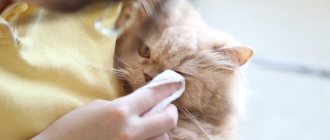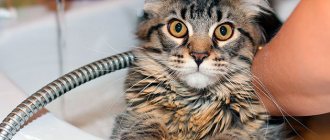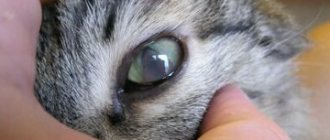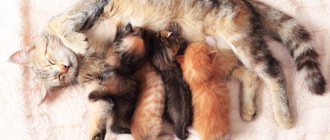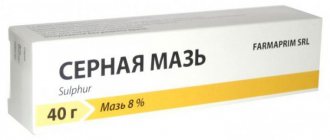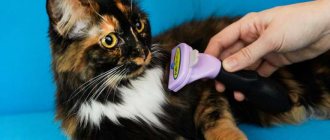I had to face a situation where it was necessary to provide emergency assistance to a cat with an eye injury from a cat’s claw, and it turned out to be possible to make an appointment with a specialist only three days later. An ordinary veterinarian could not examine the eyeball; this requires special equipment. The eye became cloudy and a milky blur appeared.
I understood that I couldn’t wait three days; I urgently needed to provide competent medical care to the pet. While surfing the Internet, I managed to find a very interesting article on this topic. The article was written for specialists and the material is difficult for the uninitiated reader to perceive, but I really needed to understand what to do. Having carefully studied the article, it became clear that an examination is necessary, but for now, regardless of the severity of the injury, it is urgent to carry out “ forced local antibacterial therapy with fluoroquinolones (Tsiprovet 2 drops 6-8 times a day) in combination with aminoglycosides (Tobrex, iris 1 drop 6-8 times a day) and corneoprotectors (solcoseryl, Actovegin 1 drop 4-6 times a day).
«
I bought ciprovet, iris and solcoseryl, drew up an hourly treatment regimen and regularly instilled eye drops, alternating medications.
When we got an appointment with an ophthalmologist, the cat's eyeball was examined. It turned out that the lens was not affected; there was no need to operate the eye. And this is largely due to the fact that the therapy helped to avoid wound infection and significant swelling of the cornea with all sorts of ensuing complications.
The doctor prescribed observation and treatment for us:
4 times a day for another 7 days (the same active ingredient as in the drug Ciprovet, only these are eye drops for people); Indocollir 4 times a day for 7-10 days (eye drops for people);
until complete recovery;
until complete recovery;
until complete recovery.
We were treated for about a month, and as a result, everything went away, the eye was completely restored.
Below is an article that I would like to share with others in case someone needs it.
Authors:
Associate Professor A.G.Shilkin, resident V.V. Oleinik
Traumatic cataracts in dogs and cats are a serious ophthalmic pathology, usually leading to blindness in the affected eye. In severe cases, with combined damage to intraocular structures and the absence of adequate treatment, complications arising from traumatic cataracts can cause the loss of the eye as an organ.
The main factors causing traumatic cataracts are penetrating wounds and contusive injuries of the eyeball.
The purpose of our work was: Determination of rational tactics for microsurgical and conservative treatment of traumatic cataract, depending on the etiology, localization of the process and age of the animal.
When and why is rinsing necessary?
Animals are not always able to remove accumulated discharge from the outer and inner corners of the eyes. Therefore, the owner needs to periodically help the pet with hygiene. In other cases, rinsing becomes one of the methods of therapy when it is necessary to cure an eye disease.
Causes and symptoms of eye diseases
There is no need to panic if your pet’s eyes begin to water - perhaps a speck of dust has landed on the cornea, and the body has activated a protective reaction in the form of profuse lacrimation. Such conditions quickly, within one day, cease without human help. But there are also more serious cases - eye damage or diseases:
- Scratches and wounds
. A pet can get eye injuries during a fight, play, or fall. Symptoms include redness, swelling, and in rare cases, bleeding.
- Foreign body entry
. Accompanied by severe lacrimation, redness of the eyelid and cornea; if the speck remains in the eye for a long time, pus may appear.
- Inflammation of the eyelids, or blepharitis
. With ordinary inflammation, the cat begins to scratch its eyes, as a result of which the eyelids turn red. With phlegmous inflammation, the eyelid swells and cloudy mucus oozes from the eye. Blepharitis often occurs after severe scratching and wounds, that is, it is a secondary infection.
- Entropion and eversion of the eyelid
. Abnormal position of the eyelid occurs when a foreign body enters, when exposed to strong chemicals, or from burns. This can lead to conjunctivitis or keratitis (inflammation of the cornea). Symptoms: lacrimation, photophobia, redness of the conjunctiva.
- Parasitosis
. Some types of helminths settle in unexpected parts of the body, including the eye area.
- Infections
– one of the most dangerous conditions. The outbreak can be concentrated only in the eye (viral conjunctivitis) or affect the entire body (distemper, chlamydia, etc.). The infection is characterized by swelling and narrowing of the eyes, copious discharge with pus, crusting and sticking of the eyelids.
- Allergy
– like a person, a cat’s eyes can become watery due to an allergy to pollen, citrus particles, perfume, etc. In this case, redness of the eyelids and strong transparent discharge are observed.
There are breeds of cats in which eye problems occur more often due to anatomical features: these are British, Rex, Sphynx. They require more careful care.
To avoid or prevent illness, it is necessary to periodically check your cat's eyes - every day, as soon as you pick up your pet, briefly examine its face. Do not forget to carefully remove accumulated dirt and vaccinate once a year.
Indications for eye rinsing
Sometimes an animal is not able to wash itself thoroughly: due to young or old age, illness, too long hair on the face and other reasons. Then it is recommended to pay attention to this once every 1-2 days - for hygiene purposes.
More frequent rinsing is needed if the pet becomes ill. Simple strong tea will not help here - you need medicines, drops and ointments. Only a veterinarian will tell you the procedure for their use after examination and making an accurate diagnosis.
Precautions
In case of severe illnesses, you should not self-medicate without the advice of a veterinarian. This can lead to serious complications, including loss of the eye. Therapy must be agreed upon with a specialist, who will also calculate the dosage and course of drug use.
If everything is not so serious and the cat needs a banal cleansing, you can carry out the procedure yourself several times until the condition improves. Remember the contraindications and precautions:
- do not rinse your eyes with plain water - it destroys the natural microflora and dries out;
- do not use cotton wool - its fibers can damage the cornea or get under the eyelid, so take cotton pads or a gauze swab;
- each eye should have its own disc or tampon to avoid spreading infection from one eye to the other;
- Do not wash your cat's eyes with chamomile infusion, as this often leads to baldness of the eyelids.
Always follow through with treatment. If after two days of washing the furry patient’s condition has not improved, contact your veterinarian.
Video “How to wipe a kitten’s eyes”
From this video you will learn how to properly wipe a kitten's eyes.
Recommended Posts
How to use Bars drops for cats and other preparations: spray, shampoo
How to properly clean a kitten's ears at home
How to properly use the drug "Bars Forte" to protect dogs from parasites
How to successfully name a white kitten boy and girl
Why do dogs have watery eyes: norms and dangerous pathologies
Chondartron for dogs: benefits and possible contraindications
How to wash a cat's eyes
In most cases, you do not have to specifically buy medicines - just open your home medicine cabinet. It will probably contain some of the tools listed below.
How to rinse a cat's eyes using medications
In any pharmacy you can buy products for people suitable for washing the eyes of animals.
You may already have them
- ready-made solution of furatsilin 0.02%;
- saline solution 9 percent;
- 2% boric acid solution;
- chlorhexidine 0.01%.
Always pay attention to the percentage! If you make a mistake, you can cause a severe chemical burn.
Other medicines from the human pharmacy cannot be used for cats - you may be confused with the dosage or intolerance. If treatment for a serious illness is required, the veterinarian will issue a prescription.
You can purchase eye wash products for cats and kittens at a veterinary pharmacy:
- “Diamond eyes” with chlorhexidine, taurine and chlorocide C, that is, the effect of the drug is complex: bactericidal and healing;
- “Bars” are medicinal drops containing furatsilin (disinfects) and novocaine (pain relievers), often used in the form of lotions.
If your cat becomes allergic to any of the medications, stop using it immediately.
Folk remedies
To prevent diseases and for minor discharge, you can use weak herbal decoctions from your home medicine cabinet. It is best to wash a kitten's eyes with herbs after consultation with a veterinarian, so as not to provoke an allergic reaction. What folk remedies can you use to wash a cat's eyes?
- a small amount of strong black tea;
- you can brew calendula: 1 tbsp. a spoonful of flowers - one mug of boiling water;
- according to the same principle - a decoction of St. John's wort;
- For a one-time procedure, chamomile is also suitable - 1 sachet/tbsp. spoon onto a mug of boiling water.
Monitor the temperature of the medicine - it should be at room temperature. Before rinsing your pet’s eyes, it is necessary to strain the broth so that foreign particles do not get into your pet’s eye and cause complications.
Medicinal eye washes
Furacilin solution
How can you wash a cat's eye to remove pus and other discharge? For this, there are many special medications that need to be purchased at a veterinary or regular pharmacy. If the visual organs are watery, then the following remedies are suitable:
- 0.02% solution of Furacilin. The substance must be diluted with water (1:5). If its concentration is exceeded, it can provoke additional irritation of inflamed eyes. In rare cases, corneal burns occur.
- Boric acid. The medicine is good for pus in the eye. 5 g (1 tsp) of powder should be dissolved in 200 ml of boiled warm water (distilled). The drug should not be used for bleeding wounds.
- Saline. It is better to purchase it at the pharmacy in ready-made proportions. After all, if the concentration is incorrectly calculated, it can cause burns to the mucous membrane of the eyes.
You can also eliminate purulent discharge with chlorhexidine. The drug should be diluted in strict accordance with the instructions, since at a high concentration of the drug it can harm the animal. A solution of potassium permanganate is often used to instill the visual organs. The liquid should be light pink with no undissolved crystals. To treat a kitten’s visual organs, you can use Diamond Eyes drops. The product will overcome almost any ophthalmological disease in pets. You can buy other drugs:
- Fosprenil;
- Anandin;
- Kanyuktyuvet.
The products should be used in strict accordance with the instructions.
Features of the procedure
There are no fundamental differences in washing the eyes of an adult animal or a kitten: the procedure for performing the procedure is almost identical. The difference lies in small nuances that will help your pet as much as possible and not cause harm.
It all starts with preparing the necessary materials - you will need:
- several clean cotton pads or pieces of gauze;
- clean cloth napkins or towel;
- syringe without a needle (for copious rinsing);
- what you will use to wipe your cat’s eyes is a solution or decoction of herbs.
For aggressive or restless animals, a towel is useful - you can wrap the animal in it - or a retaining bag.
In adults
Adult cats may resist, so you will need an assistant to hold and calm the animal. The cat must be wrapped in a towel or blanket to gently hold it and not harm it during the procedure. Once the animal has been secured, you can begin washing.
First you need to soak the dried crusts, if any. After dipping a cotton pad into the medicinal solution, you need to squeeze the product into the sore eye and wait until the crusts become softer and easier to remove. Gently wipe the disc over the eyelid, being careful not to touch the cornea. Movements should be directed from the ears to the nose, towards the tear duct. Use different pads on different eyes to avoid infection of the healthy eye.
Once the eyes are clean, pour the medicinal solution onto the cornea of the eye using a syringe without a needle - if required by treatment. Normal hygienic cleaning can be left without this step. Remove any remaining solution around the eyelids with a dry cloth or towel. Do not press and try not to touch the eyeball with the tissue so as not to injure it or cause irritation.
How to wash a kitten's eyes
Kittens do not always cope well with washing themselves, as they are accustomed to the mother cat taking care of hygiene. In the first few months, the owner needs to regularly wash the baby’s eyes so that they do not begin to stick together and fester.
The whole manipulation is almost identical to what is done for an adult cat. However, the procedure should be performed with extreme caution so as not to harm the small pet. You can do without an assistant - you can handle the baby yourself, especially if he is still sleepy. But after eating, you should not carry out the procedure - the kitten may vomit.
If, in addition to rinsing, there is a need to instill medicinal solutions or apply ointments, then precautions should be taken. Unlike adult cats, kittens should not have medicinal solutions put into their eyes immediately after rinsing: you must wait about ten minutes to minimize the risk of irritation.
If you have never owned a cat and do not know how and what to wash a kitten’s eyes with, contact your nearest veterinary clinic or an experienced breeder. You will quickly be shown all the steps of this easy and simple procedure.
Veterinarian recommendations
Most likely, your pet will be against such procedures. Most cats simply cannot tolerate eyewash. But in some cases this is simply necessary, so the animal will have to put up with it.
Try rubbing his eyes in a calm and quiet environment. Praise, pet your pet, treat his eyes as calmly as possible. Here are general recommendations on how to wash your pet's eyes:
- Be sure to wash your hands with soap. This will eliminate possible infections.
- It is advisable to carry out all manipulations together. One person will hold the cat on their lap while the other person washes the eyes. But wipe them as carefully as possible. Be prepared for the animal to resist. The cat may swing or hit with its paw, which can injure you. Anticipate all possible reactions of your pet.
- A cat's eyes are a very vulnerable place. Be sure to make sure that the animal's head is higher than its body. Rinse your eyes only in this position.
- Monitor the temperature of the liquid. The affected area can only be treated with infusions and solutions at room temperature. The liquid should not be warmer than 37 degrees, this can cause a burn. But it shouldn’t be too cold, otherwise it will be extremely unpleasant for the animal.
- A pipette, bottle or syringe is suitable for instilling liquid. They should be 1 cm away from the eye.
- If your eyes are dirty and sticky, you can rinse your eyelids first and then apply eye drops. Nothing should interfere with the procedure according to all the rules. Suppuration must be removed without fail.
- If your eyelashes are stuck together, you should first wipe the outer part of your eyes. This must be done until the cat or kitten opens its eyes completely.
- How can you dry your eyes after the procedure? For this, a regular dry cotton pad is quite suitable, which you need to gently wipe the cat’s eyes. Just don't touch the eyeball directly.
- Once you have dropped the solution into your cat's eye, gently press her eyelids together with your hands so that the liquid can be evenly distributed over the surface of the eye.
- Under no circumstances use regular cotton wool instead of cotton pads. This can injure the animal's eyes, because the fibers can get on his eyeball.
INTERESTING TO KNOW: If a cat growls and hisses for no reason
Do not wash your pet's eyes with tea if they are infected. This is not only useless, but can also harm the cat. It is better to check with your veterinarian whether this or that remedy can be used for your problem.
Be sure to consult your doctor and inform him about all manipulations that affect your four-legged friends.
How to wash the eyes of a kitten or cat as a preventive measure
It is recommended to monitor the condition of your cat's eyes from an early age. In newborn kittens, the eyes open in one to two weeks. If by the end of the third week the eyes have not opened, you need to wash them very carefully.
Adult cats take care of their own hygiene. The daily cat ritual includes washing the face and eyes. But it happens that the cat gets hurt or catches a disease - to prevent complications, periodically examine your pet. If you notice clouding or change in color of the iris, purulent discharge, or fur on the face with traces of tears, then immediately contact your veterinarian. If an injury is detected, do not let the animal rub its eye, as this irritates the mucous membrane. Do not open your pet's eyes by force. Do not use medications containing prednisolone or dexamethasone yourself - you may worsen the situation.
The treating veterinarian will advise what to wash your cat's eyes with as a preventive measure. You can soak a cotton pad with strong tea or saline solution, and then clean the eye with smooth movements. All this is necessary if the cat periodically develops brown crusts - the consequences of poor hygiene and dust getting on the cornea. This is not dangerous if the accumulations are removed from the tear corners in time.
Do not forget to vaccinate your animal once a year, without losing track of the schedule. If you have an elderly or frail pet, take it to the veterinarian regularly.
In the case when simple medications do not help and your pet’s eyes continue to fester, become swollen and stick together, it is necessary to take the animal to the veterinarian. The doctor will make an accurate diagnosis and prescribe age- and breed-appropriate treatment.
The article is of a recommendatory nature. Consult your veterinarian!
Traditional preparations for washing the eyes
Black tea
How to wash a cat's eyes at home if you don't have pharmaceuticals on hand? In this case, you can get rid of pus and other secretions using traditional methods.
- Linden tea helps a lot. Pour 5 g of flowers into 75 ml of boiling water and leave for 30 minutes. Then you need to filter the solution and rinse the animal’s affected eyes. Elderberry is also good for healing a cat’s visual organ. 10 g of raw material (dry) must be thoroughly crushed, doused with 100 ml of boiling water and covered with a lid. Leave the drug for 35-45 minutes, then strain and use for rinsing with a bandage. Up to 3-6 procedures should be performed per day.
- If your animal has a lot of pus coming out of its eyes, wash it with infusion of celandine. Grind 4-6 leaves of the plant and brew 5 ml of boiling water. Leave the drug for 15-25 minutes, strain and use for instillation into each eye (even if one is healthy). The product relieves redness and eliminates pain.
- Kittens can have inflamed eyes for no apparent reason. In this case, they can be treated with yesterday's black tea. The drink should be prepared from large-leaf tea leaves without adding sugar and infuse for at least 10-12 hours. Cotton swabs should be soaked in the preparation and applied to the animal's eyelids. Up to 6 procedures must be performed per day. Usually, discharge from the eyes disappears within a day after regular treatment with the drug.
- If your animal's eyelids stick together, you can use a decoction of calendula, chamomile, hyssop or St. John's wort. 1-2 tbsp. The selected raw material needs to be poured with a glass of boiling water and the drug infused for 7-12 minutes. The medicine must be filtered so that foreign particles do not get into the eye. Then you need to take gauze, fold it in 2-3 layers, soak it in the broth and rinse the pet’s visual organs.
- Aloe juice is used quite often. 2-3 agave leaves should be crushed to a paste or blended in a blender. Then you need to strain the agave juice and use it for instillation into the pet’s visual organs. You need to perform 2 procedures per day. For this it is better to use a pipette. To eliminate eye diseases in cats, you can use a decoction of yarrow. Pour 10 g of raw material into 250 ml of boiling water, leave for about 30 minutes, then strain. The drug should be used to wash the cat’s visual organs up to 4 times a day.
A prerequisite when using all solutions is that they must be warm, not hot or cold.
Otherwise, it will cause discomfort to the animal. When you don’t have the necessary supplies at home, you can provide first aid to your furry pet with regular boiled water at room temperature.
If a cat's eyes are running, then it is necessary to urgently take the necessary measures. To do this, you can use pharmacy or folk remedies. If the phenomenon is inflammatory in nature, then you need to contact a veterinarian.

